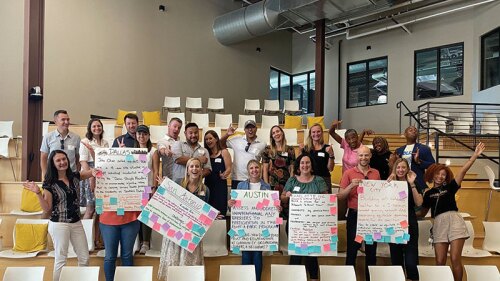Columbus, Ohio, is steadily gaining a reputation as a dynamic, amenity-rich, economically diverse city that remains affordable. In 2014, it earned the top spot in Forbes magazine’s inaugural “Opportunity Cities” ranking, a list of the best places outside of coastal markets for young professionals to establish themselves.
ULI Columbus members, who have always understood the appeal of their city, have taken steps to quantify expected growth and prepare for future demand. Half a million newcomers are expected to settle in the central Ohio region by 2050 and 300,000 jobs will be added. There is little doubt that Columbus and the seven-county region that surrounds it will grow—but how this growth happens and who will be served by it are critical questions.
The need to answer these questions was the driving force behind the insight2050 initiative, an ambitious project undertaken by ULI Columbus to provide land use decision makers with unbiased information on the growth choices and consequences that lie ahead for the region. The district council pursued the project with Columbus 2020, a regional economic development organization, and the Mid-Ohio Regional Planning Commission, the metropolitan planning organization.
“How central Ohio grows and develops is as important as the fact that it will develop,” says ULI Columbus chair Terry Foegler, a member of the insight2050 executive committee and director of strategic initiatives for the city of Dublin, a first-tier suburb of Columbus.
At the heart of an insight2050 report produced by the initiative are four possible scenarios that describe how these projections for population and job growth could play out. Developed by Calthorpe Analytics, a spinoff of Calthorpe Associates, the firm founded by ULI J.C. Nichols Prize Laureate Peter Calthorpe, the scenarios range from the low-density, automobile-oriented development patterns of the past to increasingly compact, dense, and walkable ones. Based on data generated by the Calthorpe Analytics’ RapidFire tool, the scenarios predict outcomes across a broad set of metrics—from local government expenditures to public health costs to greenhouse gas emissions.
Since the release of insight2050 in November 2014, ULI Columbus has spent 18 months sharing the scenarios and the supporting data with stakeholders, making nearly 85 presentations across the region.
“People who never considered land use as a major issue now understand that it has a significant impact on what we do and how we grow,” says Yaromir Steiner, chair of the insight2050 steering committee and chief executive officer of Steiner and Associates. “Certainly, our conclusions can be extrapolated to other parts of the United States. Insight2050 was a great opportunity for district councils to demonstrate ULI’s value.”
Not a Prescription for Growth
It was important to ULI Columbus members that insight2050 not be used to prescribe where growth should take place but instead initiate conversations about land use planning choices based on objective data. Critical to that discussion are the demographic changes and evolving housing and community preferences sweeping central Ohio. The historic demand for single-family homes and automobile-dependent communities gave rise to sprawling, outer-belt suburbs; new urban development and urban infill projects are only very recent trends.
But what is clear is that past trends are not indicative of what the future holds. The population of singles, seniors, and couples without children will rise in central Ohio, according to U.S. Census Bureau data and a study of central Ohio trends by Arthur C. Nelson, University of Arizona urban planning and real estate professor.
According to this research, the number of singles living alone and households without children will far outnumber those with children by 2040 and thereafter. Populations of people age 65 and older and people under the age of 35 are expected to grow, by 25 and 23 percent respectively. In contrast, the number of people in the 35- to 64-year-old cohort will shrink by 47 percent.
Nelson’s data and census projections enabled Calthorpe Analytics to customize the RapidFire tool to build each scenario and calculate the true cost of maintaining the status quo or adopting incremental change to prepare for future demand.
“The insight2050 scenarios explicitly explore the impacts of meeting or not meeting pretty clear housing demand and preferences,” says Joe DiStefano, principal and cofounder of Calthorpe Analytics. “Competitive regions are building the housing types that will be in demand based on demographics and preferences that are evolving.”
Incremental Steps toward Denser, More Compact Communities
By 2050, fewer people in central Ohio will prefer large-lot, single-family homes, and more will want attached homes or single-family homes on small lots, according to insight2050.
The four scenarios developed by Calthorpe Analytics for insight2050—Past Trends, Planned Future, Focused Growth, and Maximum Infill—exist on a spectrum from low-density, greenfield development to compact, high-density infill and brownfield development. The impacts of each scenario were calculated across seven metrics: square miles of land consumed; local fiscal impacts (capital and ongoing maintenance costs); transportation (vehicle-miles traveled); public health costs; building energy and water use; greenhouse gas emissions; and personal household costs.
A comparison of the impacts of Past Trends with those of Maximum Infill, which strives to maximize efficient growth through infill development and redevelopment, found that Maximum Infill results in the following:
- $80 million in cost savings in fiscal impacts on local governments;
- $6,300 per household in annual cost savings, with less personal income spent on car-related expenses like gasoline, insurance, and maintenance; and
- a 3.1 million-metric-ton cut in greenhouse gas emissions through reductions in the number of passenger vehicles, and in energy consumption from residential and commercial buildings
Though reduced carbon emissions in different scenarios are noteworthy, fiscal impacts on local governments and heavier tax burdens on personal pocketbooks will likely be more compelling for local lawmakers, DiStefano says. “Presenting the scenarios on an equal playing field, where all the comparative fiscal information is in front of them, is what creates those ‘a-ha’ moments that they wouldn’t have otherwise have,” he says.
The choices presented by insight2050 to stakeholders can be adopted incrementally: Planned Future and Focused Growth are steps between Past Trends and Maximum Infill (see graphic).
Jonathan Barnes, ULI Columbus chair for mission advancement, notes that the term density is frequently cited but often misunderstood. “I think people’s fear of density is alleviated when they see the benefits—and the flip side of that, the downside of not embracing certain kinds of density,” he says. “[Insight2050] shows that density is not just your friend, but the only way to save your community, to some degree.”
Barnes is among the land use professionals already embracing the vision presented in the Focused Growth and Maximum Infill scenarios. Insight2050 helps validate their proposals for denser, transit-oriented housing by offering skeptics hard data on the negative consequences of continuing to build housing and communities that future residents will not want.
Dublin, a suburb of Columbus, is home to major companies such as Cardinal Health and Wendy’s. Corporate and municipal leaders are eager to embrace density to provide housing for young professionals whose daily commute from Columbus to Dublin takes up to an hour. In Dublin, the new Bridge Street District is creating residential options close to major employers and a vibrant, dense urban center to complement the city’s historic downtown.
“The large employers around our site have millennials who seek [mixed-use, walkable] environments,” says Matt Starr, director of development at Crawford Hoying, the developer of Bridge Park, a mixed-use neighborhood that will be the district’s anchor. “They don’t live in Dublin today because the product isn’t there.”
Another reason behind Dublin’s embrace of density is the city’s tax base, which relies on income taxes rather than property taxes for revenue, says Vince Papsidero, Dublin’s director of planning and a member of the insight2050 executive committee. Keeping major employers—and their employees—in the area is essential for the city to expand its tax base and remain vibrant.
“For us, the conclusions of insight2050 are all about remaining at a competitive advantage,” Papsidero says. “As we became aware of demographic changes, we became concerned about our competitiveness and our ability to attract the tech and creative-class workers of the future. We also need to be able to protect our tax base.”
Learn more about insight2050 at getinsight2050.org and scenario planning at Calthorpe Analytics. Watch a video of Peter Calthorpe presenting the results of his firm’s scenario-planning process for the insight2050 report launch in 2014.




